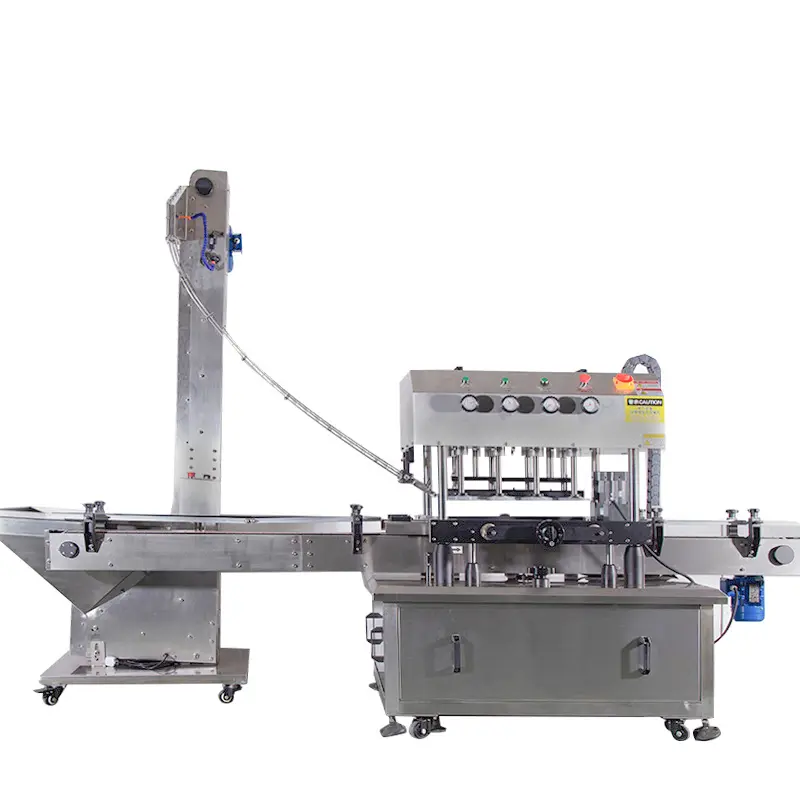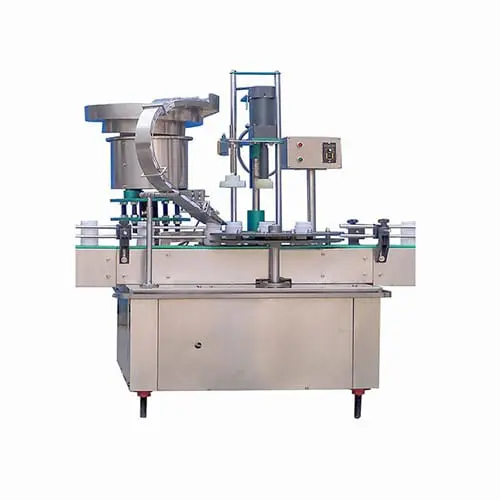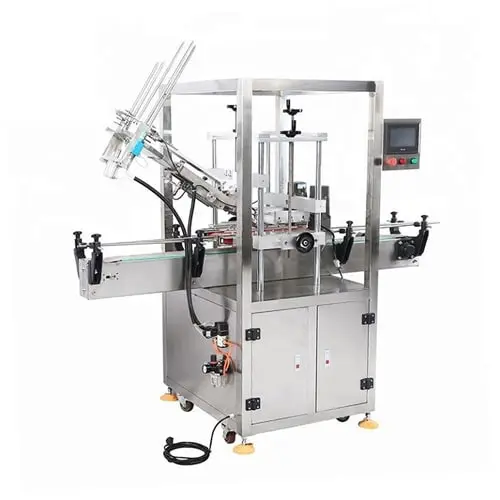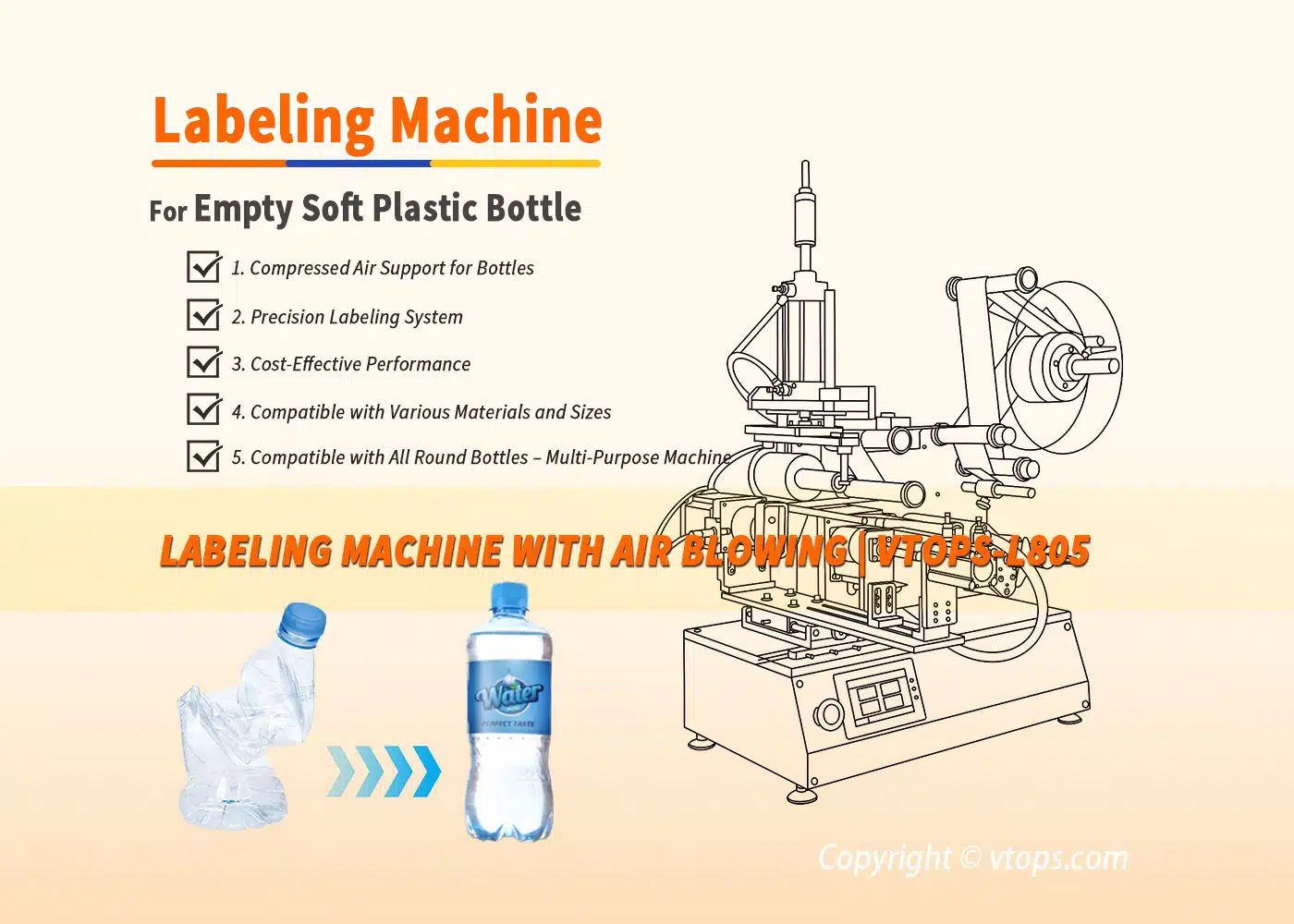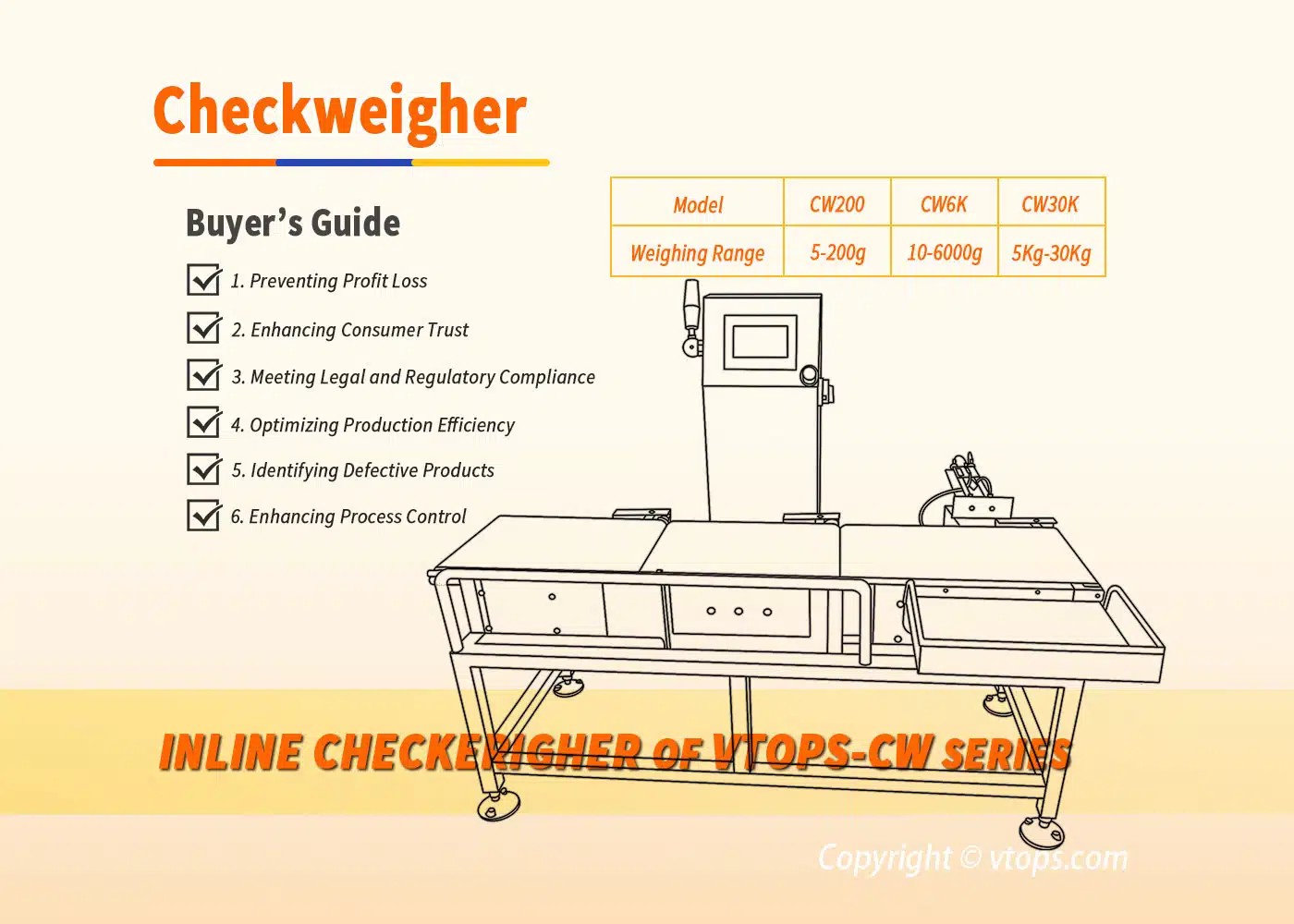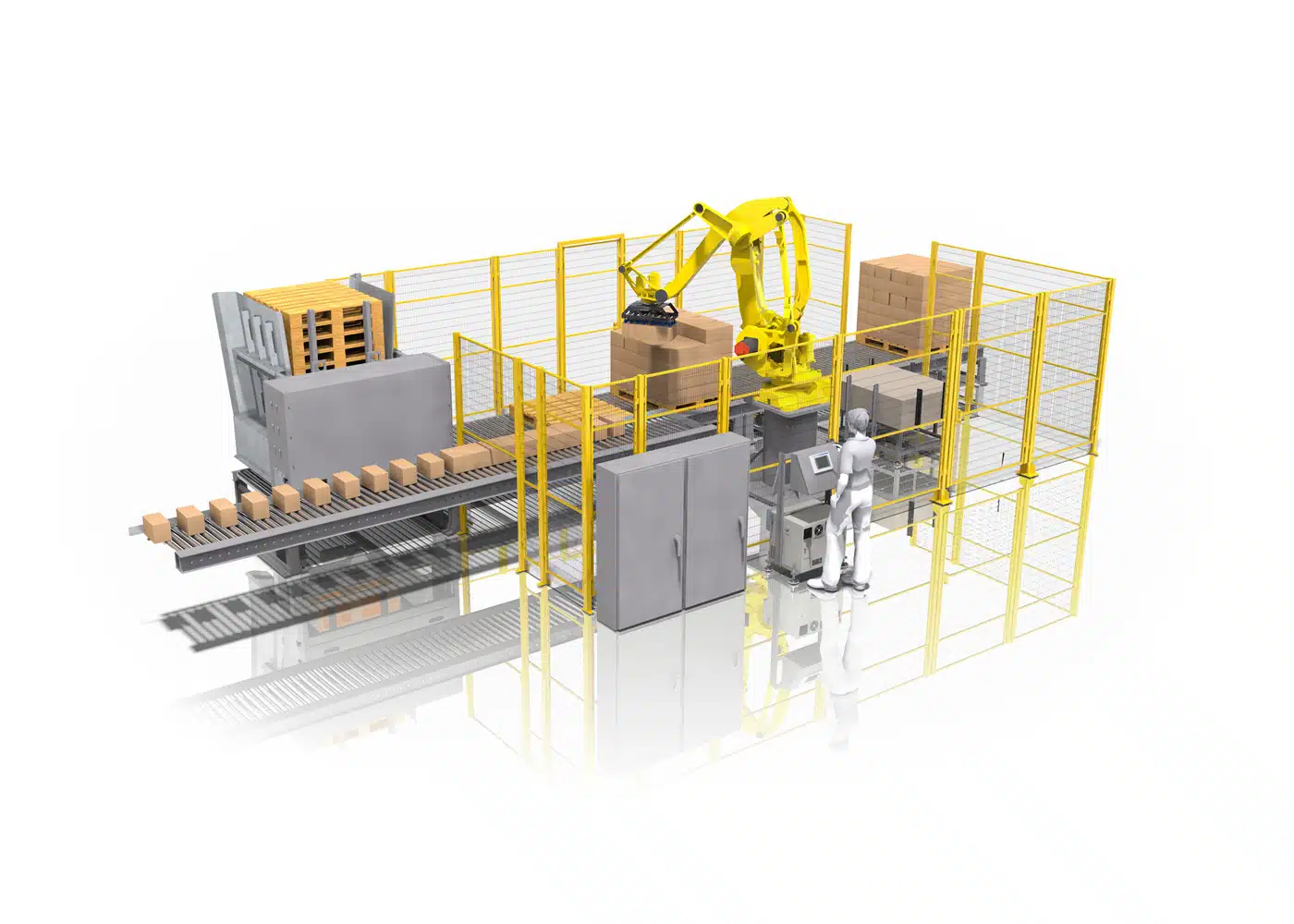Types of Capping Machines
According To the Working Principle
Screw Spindle Capping Machines
Before continuing to the cap chute on screw spindle capping machines, the caps elevator feeder the closures to ensure correctly aligned. The cap chute leads the seals to two fingers, securing the closure. The fingers enable each approaching bottle to remove the current cap in preparation for sealing.
The closure-container combination is introduced into the capping station. A stabilizer keeps the cap stable, while gripper belts maintain the container in place.
As the combination goes through the machine, spinning discs (often three or four sets) connect with the cap. The rotating discs generate the torque required to tighten the closures on the containers.
Screw Chuck Capping Machines
Screw chuck capping machines, like screw spindle capping machines, rely on vibratory bowls and cap delivery devices to transport caps to the appropriate containers. The screw chuck capping machines employ a star wheel to index the bottles underneath the capping head, allowing them to operate at high speeds.
Once a capping sensor detects the container is in the right place (such as under the chuck heads), the capping heads will be going down lower over the cap resting on the container. Then, screw chuck capping machines provide the torque to ensure correctly sealed containers.
ROPP Capping Machine
Roll On Pilfer Proof (ROPP) capping machines create the thread in the caps when the containers are sealed. Typically, these caps are unthreaded aluminum blanks pressed onto the container. The roll-on bottle capping machine is shaping around the loops on the bottlenecks. Because they do not need to impart torque, roll-on bottle capping machines do not require a clutch. The roll-on bottle capping machines have numerous heads that offer superior sealing and tamper-proof protection. However, adapting these roll-on bottle capping machines for various caps isn’t easy. Therefore it implies that the bottles must be made of heavy-duty materials to withstand the pressure.Press Push-On Bottle Capping Machines
Usually, at speeds of up to 105 caps per minute, press/push-on bottle capping machines attach push-on and press-on caps to bottles and containers. Stainless steel and anodized aluminum are often utilized in the building of Press / Push-On Bottle Capping Machines because they provide exceptional protection against corrosion, strength, and long-term durability. At Vtops, we specialize in manufacture of Press / Push-On Bottle Capping Machines that have displays that provide real-time production data. These machines show information such as the number of caps applied and the rate of production in bottles per minute, continuously. Also, capping information can be stored and retrieved at a later time for use.According To the Application
Bottle capping machine
Just like any other capping machine, the bottle capping machine closes bottle containers purposely to keep content safe for use. The most common application area is the beverage industry, and other industries dealing with chemicals or sensitive substances preserved in bottles. Using a bottle capping machine ensures that your product’s shelf life is extended since it is kept out of contamination and leakage. Beverage bottles, prescription bottles, and other containers are examples of acceptable containers that are capped using a bottle capping machine.
Using a bottle capping machine aids in the elimination of work tiredness and prevention of avoidable injuries. It is also applicable in agricultural product packagings such as solvent fertilizers, insecticides, herbicides, and pesticides.
Jar Capping Machine
Every business that loads items into any kind of jar needs a jar capping machine, where a cap is commonly used closure. The jar capping machine that is dependable is vital in any liquid packaging process in jar containers.
After passing through the jar container filling station, jar capping machines guarantee that the bottles are completely sealed. As a result, the containers become ready for the next stage in the production chain. Therefore, our jar capping machines can help you finish your packaging line and guarantee that the items you sell are packed properly.
Can Capping Machine
Can capping machines are used to seal containers like bottles and jars. Caps are used to prevent product leakage and contamination, and increase the shelf life of a product and prevent tampering.
Our Can capping machine is typically used to attach can cap to most soft drink and beverage cans. As a result, insects are kept out, and the fizz is kept within by a flip-top cover that snaps shut. On vacations and outdoor gatherings, can-capped drinks are the ideal safety net for kids and adults. Most ordinary soda cans are compatible with the Can Cap.
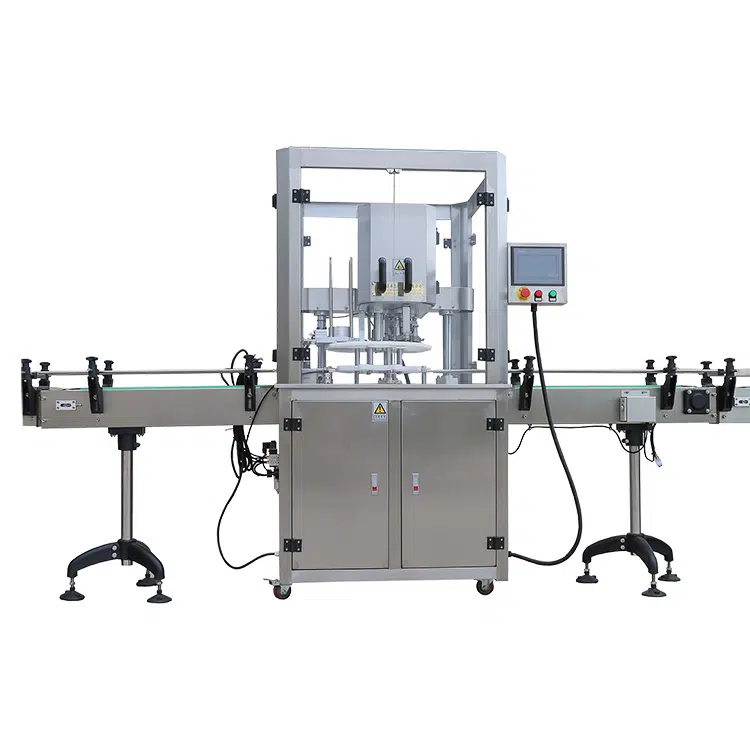
Figure 5: Can Capping Machine
Tin Capping Machine
Caps for bottles, jars, and tin cans, among other things, can be sealed using this manual tin capping machine. It is extensively utilized in a variety of sectors, including the food and beverage industry. In other words, it is widely used where no leakage is necessary. Our Tin capping machine is appropriate for filling and capping beverages such as juice, tea, mineral, and flavored water, energy drinks, and so on. Pneumatic control technology, as well as modern devices and electrical equipment, are all used alongside tin capping machines. In addition to filling slowly, it offers a variety of benefits. Such advantages include fast filling speed, liquid level control, reliable capping, frequency conversion timing, and little material loss. Tin capping machine has the capability of being fitted with a long-distance control system. In a medium-sized beer and beverage production, this is the recommended piece of equipment.Classified by the degree of automation
Automatic Capping Machine
At a rate of at least 200 bottles per minute, an automated capping machine is used in sorting, putting, and tightening caps. However, this rate is dependent on whether the cap moves continuously. The output level of caps that rely on the sporadic motion will be somewhat lower.
An automated capping machine aids in the installation of caps on top of various containers more quickly and accurately. This implies that the machine is capable of positioning, fitting, and tightening caps on a wide variety of containers. Drink bottles, medicinal bottles, and some other containers can all be capped automatically with a capping machine.
Semi-Automatic Capping Machine
The semi-automatic capping machine is used to cap bottles with plastic screw tops, metal caps, or flip-top caps. A semi-automatic capping machine is easy to use and adaptable. It can provide you with better rates of containers per minute than manual capping machines. Typically, a semi-automatic capping machine can tighten the caps at a rate of 20 containers per minute.
The semi-automatic capping machine is powered by compressed air. The advantage is that Caps from a wide variety of manufacturers will fit. This machine is appropriate for production on a small to medium scale. A semi-automatic capping machine is suitable for combustible alcohol, inks, perfumes, and paints.
Benchtop Capping Machine
Benchtop capping machines function similarly to manual capping machines, but with more torque. The torque range for the Benchtop capping machine is 4 to 100-inch pounds. It relies on a footswitch-activated air cylinder to force down the cap. Typically, an air cylinder will push down on the cap, ensuring that it is properly closed. The Benchtop capping machine assures a high level of torque with a minimal amount of manual work involved. This machine is useful in tightening caps that range from 10 mm to 130 mm. It makes capping a breeze. With is tool-less switching, all adjustments are done by hand. The machine is superb torque precision and consistency. This machine is useful in tightening caps that range from 10 mm to 130 mm. It makes capping a breeze. With is tool-less switching, all adjustments are done by hand. The machine is superb torque precision and consistency.Handheld/Manual Capping Machine
A manual capping machine is simple and versatile, and it does not need electricity to operate. Also, the handheld capping machine fits a wide variety of caps and toppers.
A manual capping machine is suitable for small-scale manufacturing like in a laboratory. This capping machine is also available with international certification for use in explosive atmospheres. A handheld capping machine is also suitable for aerosols, fragrances, and vials with crimped ends.
The benefit of using a manual capping machine guarantees cheap prices and a high level of labor. This machine is purely pneumatic that makes it simple to use and its torque reproducibility is dependent on the steady downward pressure.
Working Principle of Capping Machines
The many capping machines work on a variety of distinct operating principles. The functioning principle of the machines is usually determined by the kind of machine. Therefore, it implies that the nature of your task as an operator will be determined by the sort of capping machine you are running.
Generally, the capping machine operates by moving the cap and bottle through a series of rotating discs or spindles. The rotating motion will be transmitted to the cap through the spinning discs. The cap would then revert to its original position. There are semi-automatic spindle cappers available.
For Example a Semi Capping Machine
According to the capping machine with a standard base, the working principle is as follows.
First, you need to set a loose cap on the container and then place it on the machine’s base so that it rests against the backstop. The container is now aligned correctly beneath the capping machine and is prepared to be capped.
The air cylinder that needs to drive the capping machine up and down should then be operated with a foot pedal. The air cylinder drops onto the cap to be tightened when the foot pedal is depressed, lowering the capping machine with a connected chuck.
When the chuck makes contact with the cap, it is pushed slightly up into the capping machine, so initiating the capping motor. The capping machine tightens the cap in milliseconds and then shuts off automatically. It operates similarly to a pulse.
When the capping machine comes to a complete stop, you should depress the foot pedal. This enables the capping motor and connected chuck to rise off the cap and return to its starting place. The base of the capping machine may now be removed, revealing the perfectly sealed bottle.
Applications of Capping Machine
Our capping machines, like other of packaging machinery, are used in a variety of industries. Several of these industries include the following:
General Packaging Applications
The capping machine is used in the general packaging of sensitive products. In a number of industrial situations, the capping machine can be employed. The equipment is often used to aid in the process of inserting and tightening packages’ caps. The cosmetics industry, for example, uses a variety of containers to keep its product safe. The delicate nature of chemical goods necessitates the use of the equipment.
Food and Beverage Processing Applications
Drinks and food items are kept secure with the use of a capping machine. Almost all of the beverages you drink come in a can or a bottle. In addition, food processing firms use containers that are easy to shatter to preserve food. Capping machines aid in the capping of food containers in all of these procedures.
These drinks require safe handling and are sensitive to contaminants, thus they are capped tightly using a capping machine.
Agricultural Applications
The capping machine is used in the agricultural industry to prevent the harmful or poisonous effect of the substances from reach of children and other vulnerable groups. For example, while purchasing pesticides and solvent fertilizers, among other agricultural products, you can notice they are packaged in airtight containers. To ensure that the caps are impenetrable to tampering, capping machines are used by agricultural input providers.
Agricultural businesses of all sizes will buy liquid agrochemicals from producers to boost crop production. More organisms that destroy crops in the field may be controlled using herbicides and pesticides, insecticides and algaecides, and other substances. Soil conditioners and fertilizers, for example, are agrochemicals that aid plant development.
When these substances are physically handled or breathed, they may be exceedingly dangerous. When it comes to manufacturing and packing these chemicals in variable liquid quantities and inventory stock numbers, a capping machine is an essential answer.
Medical and Military Products
The capping machine is widely used in medical and military industries. Pharmaceutical companies often use a wide range of packaging materials when creating and delivering medication. This does not change in the slightest when it comes to military equipment. These industries need very tight seals because of their sensitivity. The tamper-proof seals are made by capping machines to prevent contamination.
Most of these products may be poisonous and sensitive to contamination. They are kept safe for use, by fixing caps tightly using capping machines.
Things to Consider When Buying a Can Capping Machine
It is much more challenging to buying a capping machine perfect for your business from the existing market due to the many models and styles to dazzle you.
To help you make the right decision, VTOPS has analyzed several factors to help you in your search. Please click here to visit more.
How Can a Capping Machine Benefit Your Business?
Capping Accuracy
Firstly, the capping machines will speed up capping and improve capping accuracy. The capping procedure may be automated, ensuring that each lid snaps into place perfectly. Capping bottles at a faster pace increases productivity. Because of this, you’ll be able to meet or exceed market demand.
Cross-pollution
Secondly, human mistake is common when items are handled by hand. Moreover, it is tiresome and time-consuming to sift and snap caps into position over and over again. At some time, the individuals performing the work will be exhausted and worn out. And the labor will inevitably contaminate the caps and even the product inside the bottle.
As a result, there is the potential for expensive mistakes to be made. Therefore, capping machines help to minimize contamination. As a result, there is less likelihood for contamination of the cap.
Increase Productivity
Thirdly, engaging in a capping machine as a company is a smart move to enhance return on investment while saving on extra costs. The expense of acquiring and putting up the essential infrastructure might be prohibitive. Your investment will pay off sooner, though. Because hand capping is both costly and unsustainable, this is the reason. Automated capping machines are more efficient than employing many individuals to do physically demanding tasks. People will be able to focus on more essential duties since you will have freed them from tedious physical labor.
Adaptability
Reliable & Dependable
Anyway, a capping machine will be beneficial to your production and business. At Zhengzhou Vtops Machinery Co Ltd, we specialize in large-scale production and customization of packaging machines, not limited to capping machines, so do not hesitate to contact us if you need.
Conclusion
Efficacious cap tightening machines are essential in various industries, from food manufacturing to pharmaceuticals, military, and agriculture. Choosing the correct model will help you get the most out of your investment.
In addition to providing some insight into how capping machines operate, the knowledgeable technicians at Vtops Company are well-versed in the integration of capping machines into production lines. We can assist you in developing a strategy for moving ahead.
Vtops Company has a variety of capping machines, including manual, automatic capping machines like spindle cappers, chuck cappers. Other machines include Roll-On Bottle Capping Machines, snap cappers, ROPP cappers, and Press / Push-On Bottle Capping Machines.

